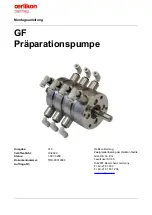
Commissioning, Startup, Operation, and Shutdown
Start the pump
WARNING:
Immediately observe the pressure gauges. If discharge pressure is not quickly attained, stop
the driver immediately, reprime, and attempt to restart the pump.
CAUTION:
• Immediately observe the pressure gauges. If discharge pressure is not quickly attained, stop the
driver, reprime, and attempt to restart the pump.
• Observe the pump for vibration levels, bearing temperature, and excessive noise. If normal levels
are exceeded, shut down the pump and resolve the issue.
• On pure or purge-oil mist-lubricated units, remove the viewing port plugs to verify that oil mist
flowing properly. Replace the plugs.
• On frame mounted units, ensure that the oil level is correct prior to starting pump. Close coupled
pumps do not have oil lubricated bearings.
• Ensure all flush and cooling systems are operating correctly prior to starting pump.
Before you start the pump, you must perform these tasks:
• Open the suction valve.
• Open any recirculation or cooling lines.
1. Fully close or partially open the discharge valve, depending on system conditions.
2. Start the driver.
3. Slowly open the discharge valve until the pump reaches the desired flow.
4. Immediately check the pressure gauge to ensure that the pump quickly reaches the correct
discharge pressure.
5. If the pump fails to reach the correct pressure, perform these steps:
a) Stop the driver.
b) Prime the pump again.
c) Restart the driver.
6. Monitor the pump while it is operating:
a) Check the pump for bearing temperature, excessive vibration, and noise.
b) If the pump exceeds normal levels, then shut down the pump immediately and correct
the problem.
A pump can exceed normal levels for several reasons. See Troubleshooting for
information about possible solutions to this problem.
7. Repeat steps 5 and 6 until the pump runs properly.
Model 3610, API Type BB1 API 610 11th Edition Installation, Operation, and Maintenance Manual
53
















































